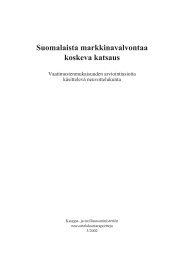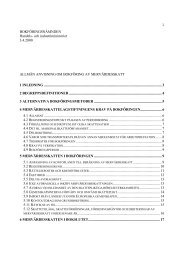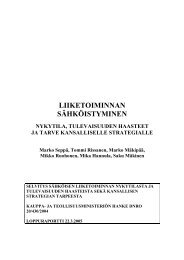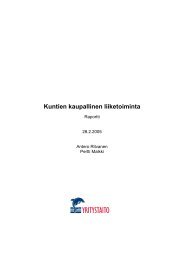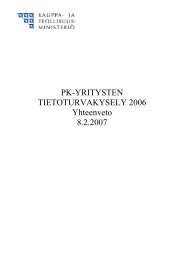Knowledge Intensive Services' Suppliers and Clients
Knowledge Intensive Services' Suppliers and Clients
Knowledge Intensive Services' Suppliers and Clients
Create successful ePaper yourself
Turn your PDF publications into a flip-book with our unique Google optimized e-Paper software.
51<br />
Leiponen (2002) raises an additional question: what are the consequences of<br />
different ways of managing knowledge across the supplier-client interface? He<br />
explores the relations between allocation of control rights over intellectual assets<br />
between a business service supplier <strong>and</strong> its client, on the one h<strong>and</strong>, <strong>and</strong> innovation<br />
outcomes on the other. A major conclusion is that KIBS suppliers who retain<br />
control of their own intellectual output are liable to be more innovative. Thus<br />
that business service firms seem more likely to be innovative if their internal<br />
knowledge resources are controlled organisationally, or collectively, as opposed to<br />
being controlled by individual experts. Why might this be? One factor may be the<br />
increased scope for diffusion of knowledge, <strong>and</strong> for bringing together <strong>and</strong><br />
synthesising different knowledges, within the firm; another might be that where<br />
there is organisational control of knowledge, there is liable to be more support for<br />
investment in R&D <strong>and</strong> other innovation-oriented activities. Another conclusion<br />
concerns the role of KIBS clients. Especially when they are in long term<br />
relationships with the service supplier, client firms will need to steer a careful path.<br />
They may well want to control outsourced service activities, <strong>and</strong> the intellectual<br />
property resulting from these; but they will lose out if such controls are so intense as<br />
to reduce the KIBS’ incentives to invest in learning <strong>and</strong> innovation.<br />
<strong>Clients</strong> can be important for KIBS internal processes <strong>and</strong> knowledge bases. Thus<br />
Muller & Zenker (2001) <strong>and</strong> Strambach (2001) b6th suggest that KIBS firms can<br />
develop their own knowledge base <strong>and</strong> innovation capability through interaction<br />
with clients in various ways.The interaction may pose new technical problems that<br />
require solutions, may involve sharing knowledge about these problems, may link<br />
KIBS to sectoral innovation systems <strong>and</strong> other innovative firms, etc.<br />
One source of information as to the influence of client interactions on KIBS comes<br />
from Tether’s (2001) of the CIS-2 survey data for the EU. Table 6 sets out some of<br />
the results he presents. First, the data confirm that the technology-oriented KIBS<br />
(technical <strong>and</strong> computer services in particular, followed by financial services) are<br />
more innovative than the other services sectors studied. Second, we can examine<br />
the firms’ ranking of the importance of various ‘sources of information’ – in Table<br />
6 these sources are ranked in order of with the proportion of firms that indicated<br />
they were ‘very important’ (<strong>and</strong> the data also display the proportion that indicated<br />
that the source was at least ‘relevant’). Third, we also have data on whom the firms<br />
collaborate with in innovation projects.<br />
‘Sources within the firm’ itself emerge as the most cited source of information for<br />
innovation. Amongst the various external sources of information for innovation,<br />
the most widely identified as being both relevant <strong>and</strong> very important were<br />
customers (or clients): this is most striking for computer services KIBS. Apart from




